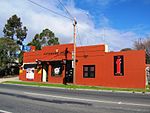Golden Square railway station
Golden Square railway station was located on the Bendigo line. It served the southern Bendigo suburb of Golden Square. The station closed to passenger traffic on 4 October 1981, as part of the New Deal timetable for country passengers.In September 1987, the signal box and all signals were abolished, except for one post, and the station was disestablished as a block post. All points were spiked normal, and were removed at a later date.Since around 1990, the station building Melbourne-bound side has been leased by a community radio station, KLFM, while the smaller down-side building has been leased in the past. In April 2008, renovations were carried out to the down-side building, including re-stumping and the replacement of weatherboards.
Excerpt from the Wikipedia article Golden Square railway station (License: CC BY-SA 3.0, Authors).Golden Square railway station
Coach Street, Bendigo Golden Square (Golden Square)
Geographical coordinates (GPS) Address Website Nearby Places Show on map
Geographical coordinates (GPS)
| Latitude | Longitude |
|---|---|
| N -36.7742 ° | E 144.2603 ° |
Address
Radio KLFM
Coach Street
3555 Bendigo, Golden Square (Golden Square)
Victoria, Australia
Open on Google Maps





